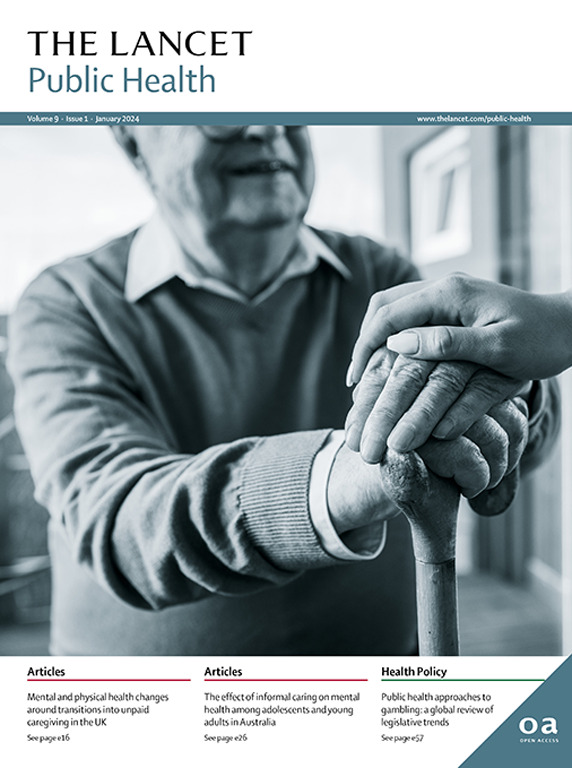Drivers of human papillomavirus vaccine uptake in migrant populations and interventions to improve coverage: a systematic review and meta-analysis
IF 25.2
1区 医学
Q1 PUBLIC, ENVIRONMENTAL & OCCUPATIONAL HEALTH
引用次数: 0
Abstract
Background
WHO's Cervical Cancer Elimination Initiative has set a target for 90% of girls to be fully vaccinated against human papillomavirus (HPV) by the age of 15 years by 2030, to substantially reduce deaths from cervical and other HPV-related cancers. However, progress has been slow, with only 27% global vaccine coverage in 2023. Migrants are an under-immunised group globally for many vaccine-preventable diseases, with data showing that they experience a high burden of HPV infection and widespread HPV under-immunisation. We aimed to identify drivers of HPV vaccine uptake in migrants, as well as assess uptake and explore recommended approaches, strategies, and best practices to promote uptake in migrant communities.Methods
In this systematic review and meta-analysis, we searched seven databases and several grey literature sources for information published in any language between Jan 1, 2006, and Dec 4, 2024, on the drivers of HPV vaccine uptake among migrants globally. Defining migrants as foreign-born nationals, we included qualitative and quantitative cross-sectional studies, cohort studies, and randomised controlled trials focused on first-generation and second-generation migrants and excluded studies of internal migrants. Outcomes were frequency and percentage of HPV vaccine uptake; factors positively or negatively influencing uptake; and recommended approaches, strategies, and best practices to promote uptake as reported by study authors or participants. We conducted a hybrid thematic analysis using the WHO Behavioural and Social Drivers of Vaccination model to map drivers of uptake, and a random-effects meta-analysis to calculate pooled estimates of uptake. Risk of bias was assessed using Joanna Briggs Institute checklists. This study is registered with PROSPERO, CRD42022347513.Findings
Of 3562 records returned by the search, 117 studies were included in the analysis, involving 5 638 838 participants across 16 countries and one territory, of whom 933 189 were first-generation and second-generation migrants. The pooled estimates of HPV vaccine uptake were 23·0% (95% CI 10·0–44·0; I2=99·3%; n=7614) among female migrants, 21·0% (5·0–58·0; I2=99·3%; n=2764) among male migrants, and 17·0% (8·0–33·0; I2=98·0%; n=3583) among male and female migrants combined. 79 (68%) studies were considered at low risk of bias, 32 (27%) were considered at moderate risk, and six (5%) were considered at high risk. Factors negatively influencing vaccine uptake included concerns about vaccine safety, cultural beliefs, uncertainty and low levels of knowledge about HPV vaccines or infection, exposure to negative information, and lack of recommendations from health-care providers. Practical barriers to uptake included little information on services, language barriers, logistical challenges, and the high cost of the vaccine. Enablers mainly included positive perceptions and trust in the vaccine and health-care providers, realistic expectations from parents regarding adolescents' sexual activity, a sense of responsibility, recommendations from health-care providers, and support from social networks. Recommended strategies and interventions to improve uptake included culturally sensitive messaging and tailored communication for different target groups (eg, parents or caregivers and adolescents). Deploying trusted mediators (eg, peer school health promoters, religious champions, and community health workers) was key, alongside implementing practical solutions to address missed opportunities (eg, bundling HPV vaccination with other services), implementing eHealth initiatives, ensuring strong provider recommendations, reducing access barriers (eg, through walk-in, mobile, and outreach services), and strengthening vaccination monitoring systems.Interpretation
We show that migrants globally face complex individual, family and social, and provider-level and system-level barriers to HPV vaccination, resulting in low uptake of HPV vaccines and missed opportunities for protection. In many low-income and middle-income countries, there is little to no availability of vaccines and/or the recipient must pay for them. Achieving global commitments to universal and equitable immunisation across the life course—and making progress towards cervical cancer elimination—requires these barriers to be addressed through multipronged strategies. Collaborative efforts with migrant communities are essential to co-develop effective, tailored delivery models that meet their unique needs.Funding
The National Institute for Health and Care Research, the Academy of Medical Sciences, and the Medical Research Council.移民人群中人乳头瘤病毒疫苗接种的驱动因素和提高覆盖率的干预措施:一项系统综述和荟萃分析
世卫组织消除宫颈癌行动制定了到2030年90%的15岁女孩全面接种人乳头瘤病毒(HPV)疫苗的目标,以大幅减少宫颈癌和其他HPV相关癌症的死亡。然而,进展缓慢,到2023年全球疫苗覆盖率仅为27%。在全球范围内,移民是许多疫苗可预防疾病的免疫不足群体,数据显示,他们感染HPV的负担很高,并且普遍存在HPV免疫不足。我们的目的是确定移民中HPV疫苗接种的驱动因素,以及评估接种情况,并探索推荐的方法、策略和最佳实践,以促进移民社区的接种。方法在这项系统回顾和荟萃分析中,我们检索了7个数据库和几个灰色文献来源,以获取2006年1月1日至2024年12月4日期间以任何语言发表的关于全球移民中HPV疫苗接种驱动因素的信息。将移民定义为外国出生的国民,我们纳入了定性和定量横断面研究、队列研究和随机对照试验,重点关注第一代和第二代移民,排除了国内移民的研究。结果是HPV疫苗接种的频率和百分比;积极或消极影响摄取的因素;并根据研究作者或参与者的报告,推荐的方法、策略和最佳实践来促进吸收。我们使用世卫组织接种疫苗的行为和社会驱动因素模型进行了混合主题分析,以绘制接种的驱动因素图,并进行了随机效应荟萃分析,以计算接种的汇总估计。使用乔安娜布里格斯研究所的检查表评估偏倚风险。本研究已注册为PROSPERO, CRD42022347513。在检索返回的3562份记录中,有117项研究纳入了分析,涉及16个国家和一个地区的563838名参与者,其中933189人是第一代和第二代移民。HPV疫苗接种率的汇总估计值为23.0% (95% CI 10.0 - 44.0;I2 = 99·3%;N =7614),占21.0% (5.0 ~ 58.0;I2 = 99·3%;N =2764), 17.0% (8.0 ~ 33.0;I2 = 98·0%;N =3583)。79项(68%)研究被认为是低风险偏倚,32项(27%)研究被认为是中等风险,6项(5%)研究被认为是高风险。对疫苗接种产生负面影响的因素包括对疫苗安全性的担忧、文化信仰、对人乳头瘤病毒疫苗或感染的不确定性和低水平知识、接触负面信息以及缺乏卫生保健提供者的建议。实际障碍包括有关服务的信息很少、语言障碍、后勤挑战以及疫苗的高成本。促进因素主要包括对疫苗和保健提供者的积极看法和信任、父母对青少年性活动的现实期望、责任感、保健提供者的建议以及社会网络的支持。改善吸收的建议战略和干预措施包括针对不同目标群体(如父母或照顾者和青少年)的文化敏感信息和量身定制的沟通。部署值得信赖的调解者(例如,同侪学校健康促进者、宗教倡导者和社区卫生工作者)是关键,同时实施切实可行的解决方案,以弥补错失的机会(例如,将HPV疫苗接种与其他服务捆绑在一起),实施电子卫生倡议,确保提供者提供强有力的建议,减少获取障碍(例如,通过上门服务、移动服务和外展服务),以及加强疫苗接种监测系统。研究表明,全球移民面临着复杂的个人、家庭和社会、提供者层面和系统层面的HPV疫苗接种障碍,导致HPV疫苗的吸收率低,错失了获得保护的机会。在许多低收入和中等收入国家,几乎没有疫苗和/或接种者必须付费。实现在整个生命过程中普遍和公平接种疫苗的全球承诺,并在消除宫颈癌方面取得进展,需要通过多管齐下的战略来解决这些障碍。与移民社区的合作努力对于共同开发满足其独特需求的有效、量身定制的交付模式至关重要。资助国家卫生和保健研究所、医学科学院和医学研究委员会。
本文章由计算机程序翻译,如有差异,请以英文原文为准。
求助全文
约1分钟内获得全文
求助全文
来源期刊

Lancet Public Health
Medicine-Public Health, Environmental and Occupational Health
CiteScore
55.60
自引率
0.80%
发文量
305
审稿时长
8 weeks
期刊介绍:
The Lancet Public Health is committed to tackling the most pressing issues across all aspects of public health. We have a strong commitment to using science to improve health equity and social justice. In line with the values and vision of The Lancet, we take a broad and inclusive approach to public health and are interested in interdisciplinary research.
We publish a range of content types that can advance public health policies and outcomes. These include Articles, Review, Comment, and Correspondence. Learn more about the types of papers we publish.
 求助内容:
求助内容: 应助结果提醒方式:
应助结果提醒方式:


